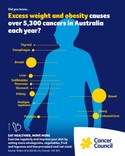Excess body fat increases insulin resistance, whereby the body produces more insulin and insulin-like growth factor 1, which can promote the growth of cancer cells. Excess body weight can also increase hormone production which is linked to endometrial and breast cancer (post-menopausal).
Cancer Council recommendations
Reduce your risk of cancer by achieving and maintaining a healthy body weight. Aim to maintain the balance between what you eat and drink and how physically active you are.
In particular, aim for a waist circumference of less than 94 cm for men, and 80 cm for women, as waist circumference is a more accurate measure of health status when compared to weight and body mass index (BMI).
Waist circumference and cancer risk
Waist circumference is one way to measure body weight. For some diseases—including post-menopausal breast cancer—fat carried around the abdomen and waist is a greater risk than fat carried on the hips and thighs.
- Find the top of your hip bone and the bottom of your ribs.
- Place a tape measure midway between these points and wrap it around your waist.
- Breathe out normally and check your measurement in centimetres.
Men should aim for a waist circumference below 94 cm.
Women should aim for a waist circumference below 80 cm

